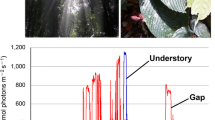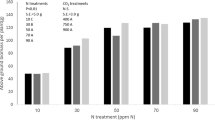Abstract
A range of studies of C3 plants have shown that there is a change in both the carbon flux and the pattern of nitrogen allocation when plants are grown under enhanced CO2. This paper examines evidence that allocation of nitrogen both to and within the photosynthetic system is optimised with respect to the carbon flux. A model is developed which predicts the optimal relative allocation of nitrogen to key enzymes of the photosynthetic system as a function of CO2 concentration. It is shown that evidence from flux control analysis is broadly consistent with this model, although at high nitrogen and under certain conditions at low nitrogen experimental data are not consistent with the model. Acclimation to enhanced CO2 is also assessed in terms of resource allocation between photosynthate sources and sinks. A means of assessing the optimisation of this source-sink allocation is proposed, and several studies are examined within this framework. It is concluded that C3 plants probably possess the genetic feedback mechanisms required to efficiently ‘smooth out” any imbalance within the photosynthetic system caused by a rise in atmospheric CO2.
Similar content being viewed by others
Abbreviations
- A:
-
net rate of CO2 assimilation
- c i :
-
intercellular CO2 concentration
- CR A :
-
flux control coefficient for Rubisco with respect to flux A
- FBPase:
-
fructose 1,6-bisphosphatase
- kapp :
-
apparent catalytic rate constant
- PCO:
-
photorespiratory carbon oxidation
- PCR:
-
photosynthetic carbon reduction
- PPFD:
-
photosynthetically active photon flux density
- Rubisco:
-
ribulose 1,5-bisphosphate carboxylase/oxygenase
- RuBP:
-
ribulose 1,5-bisphosphate
- Ru5P:
-
ribulose 5-phosphate
- SBPase:
-
sedoheptulose 1,7-bisphosphatase
References
Allen LHJr (1990) Plant responses to rising carbon dioxide and potential interactions with air pollutants. J Env Qual 19: 15–34
Andrews TJ and Lorimer GH (1987) Rubisco: Structure, mechanisms and prospects for improvement. In: Barber J (ed) The Biochemistry of Plants, Vol 10, pp 131–218. Academic Press, New York
Arp WJ (1991) Effects of source-sink relations on photosynthetic acclimation to elevated CO2. Plant Cell Environ 14: 869–875
Ashton AR (1982) A role for ribulose 1,5-bisphosphate carboxylase as a metabolite buffer. FEBS Lett 145: 1–7
Bowes G (1991) Growth at elevated CO2: Photosynthetic responses mediated through Rubisco. Plant Cell Environ 14: 795–806
Coleman JS, McConnaughay KDM and Bazzaz FA (1993) Elevated CO2 and plant nitrogen-use: Is reduced tissue nitrogen concentration size-dependent? Oecologia 93: 195–200
Conroy JP, Milham PJ and Barlow EWR (1992) Effect of nitrogen and phosphorous availability on the growth response of Eucalyptus grandis to high CO2. Plant Cell Environ 15: 843–847
Cowan IR (1986) Economics of carbon fixation in higher plants. In: Givnish TD (ed) On the Economy of Plant Form and Function, pp 133–167 Cambridge, Cambridge University Press
Crafts-Bradner SJ, Salvucci M and Eglic DB (1991) Fruit removed in soybean induces the formation of an insoluble form of ribulose 1,5-bisphosphate carboxylase-oxygenase in leaf extracts. Planta 183: 300–306
Cure JT and Acock B (1986) Crop responses to carbon dioxide doubling: A literature survey. Ag For Meteorol 38: 127–145
Evans JT (1988) The relationship between electron transport components and photosynthetic capacity of pea leaves grown at different irradiances. Aust J Plant Physiol 14: 157–170
Farquhar GD (1979) Models describing the kinetics of ribulose bisphosphate carboxylase/oxygenase. Arch Biochem Biophys 193: 456–468
Farquhar GD, VonCaemmerer S and Berry JA (1980) A biochemical model of photosynthetic CO2 fixation in leaves of C3 species. Planta 149: 78–90
Farrar JF and Williams ML (1991) The effect of increased atmospheric carbon dioxide and temperature on carbon partitioning, source-sink relations and respiration. Plant Cell Environ 14: 819–830
Givnish TD (1986) On the Economy of Plant Form and Function Cambridge University Press, Cambridge
Harley PC, Thomas RB, Reynolds JP and Strain BR (1992) Modelling photosynthesis of cotton grown in elevated CO2. Plant Cell Environ 15: 271–282
Herold A (1980) Regulation of photosynthesis by sink activity: The missing link. New Phytol 86: 131–144
Kacser H and Burns JA (1973) The control of flux. Symp Soc Exp Biol 27: 65–104
Krapp A, Quick WP and Stitt M (1991) Ribulose 1,5-bisphosphate carboxylase-oxygenase, other Calvin cycle enzymes, and chlorophyll decrease when glucose is supplied to mature spinach leaves via the transpiration stream. Planta 186: 58–69
Krapp A, Hofman B, Schafer C and Stitt M (1993) Regulation of the expression of rbcS and other photosynthetic genes by carbohydrates — a mechanism for the sink regulation of photosynthesis. Plant J 3: 817–828.
Laisk A and Eichelmann H (1989) Towards understanding oscillations: a mathematical model of the biochemistry of photosynthesis. Phil Trans R Soc Lond B 323: 369–384
Leegood RC, Foyer CH and Walker DA (1985) Regulation of the Bensen-Calvin cycle. In: Barber J and Baker NR (eds) Photosynthetic Mechanisms and the Environment, pp 191–258, Elsevier, New York
Mott KA (1990) Sensing of atmospheric CO2 by plants. Plant Cell Env 13: 731–737
Mott KA, Jensen RG, O'Leary JW and Berry JA (1984) Photosynthesis and ribulose 1,5-bisphosphate concentrations in intact leaves of Xanthium strumarium L. Plant Physiol 76: 968–71
Portis A (1990) Rubisco activase. Biochim Biophys Acta 1015: 15–28
Quick WP, Fichtner K, Schultze E-W, Wendler R, Leegood RC, Mooney H, Rodermel SR, Bogorad L and Stitt M (1992) Decreased ribulose 1,5-bisphosphate carboxylase/oxygenase in transgenic tobacco transformed with ‘antisense’ rbcS. Planta 188: 522–531
Roland-Bamford AJ, Baker JT, Allen LHJr and Bowes G (1991) Acclimation of rice to changing atmospheric carbon dioxide concentration. Plant Cell Environ 14: 577–583
Sage RF and Sharkey TD (1987) The effect of temperature on the occurrence of O2 and CO2-insensitive photosynthesis in field-grown plants. Plant Physiol 84: 658–664
Sage RF, Sharkey TD and Seeman JR (1989) Acclimation of photosynthesis to elevated CO2 in five C3 species. Plant Physiol 84: 590–96
Sheen J (1990) Metabolic repression of transcription in higher plants Plant Cell 2: 1027–1038
Socias FX, Medrano H and Sharkey TD (1993) Feedback limitation of photosynthesis of Phaseolus vulgaris L. grown in elevated CO2. Plant Cell Environ 16: 81–86
Soinit N (1983) Response of soybean to two levels of mineral nutrition in a CO2-enriched atmosphere. Crop Sci 23: 329–333
Stitt M (1991) Rising CO2 levels and their potential significance for carbon flow in photosynthetic cells. Plant Cell Environ 14: 741–762
Stitt M, Hucer SC and Kerr P (1987) Control of photosynthesis and sacrose synthesis. In: Hatch MD and Boardman NK (eds) Biochemistry of Plants, Vol 10, pp 327–409. Academic Press, New York
Stitt M, VonSchaewen A and Willmitzer L (1990) Sink regulation of photosynthetic metabolism in transgenic tobacco plants expressing yeast invertase in their cell wall involves a decrease of the Calvin-cycle enzymes and an increase of glycolyac enzymes. Planta 83: 40–50
VonCaemmerer S and Farquhar GD (1981) Some relationships between the biochemistry of photosynthesis and gas exchange in leaves. Planta 153: 376–387
VonCaemmerer S and Farquhar GD (1984) Effects of partial defoliation changes of irradiance during growth, shortterm stress and growth at enhanced CO2 on the photosynthetic capaety of leaves of Phaseolus vulgaris L. Planta 160: 320–329
Wardlaw IF (1990) The control of carbon partitioning in plants. New Phytol 116: 341–381
Webber AN, Nie G-Y and Long SP (1994) Acclimation of photosynthetic proteins to rising atmospheric CO2. Photosynth Res 39: 413–425 (this issue)
Wong SC (1979) elevated atmospheric partial pressure of CO2 and plant growth. I. Interactions of nitrogen nutrition and photosynthetic capacity in C3 and C4 plants. Oecologia 44: 68–74
Wong SC, Kriedemann PE and Farquhar GD (1992) CO2 × nitrogen interactions on seedling growth of four species of Eucalypt. Aust J Bot 40: 457–72
Woodrow IE (1993a) Modelling C3 photosynthesis: A sensitivity analysis of the photosynthetic carbon reduction cycle. Planta 191: 421–432
Woodrow IE (1993b) Control of steady-state photosynthesis in sunflowers growing in enhanced CO2. Plant Cell Environ 17 (in press)
Woodrow IE and Berry JA (1988) Enzymatic regulation of photosynthetic CO2 fixation in C3 plants. Ann Rev Plant Physiol Plant Mol 39: 533–94
Woodrow IE and Mott KA (1988) A quantitative assessment of the degree to which RuBP carboxylase/oxygenase determines the steady-state rate of photosynthesis during sun-shade acclimation in Helianthus annuus. Aust J Plant Physiol 15, 253–262
Zimmermann G, Kelly GJ and Latzko E (1976) Efficient purification and molecular properties of spinach chloroplast fructose 1,6-bisphosphatase. Eur J Biochem 70: 361–367
Zimmermann G, Kelly GJ and Latzko E (1978) Purification and properties of spinach leaf cytoplasmic fructose 1,6-bisphosphatase. J Biol Chem 253: 5952–5965
Ziska LH, Drake BG and Chamberlain S (1990) Long-tern photosynthetic response in single leaves of a C3 and C4 salt marsh species grown at elevated atmospheric CO2 in situ. Oecologia 83: 469–472
Author information
Authors and Affiliations
Rights and permissions
About this article
Cite this article
Woodrow, I.E. Optimal acclimation of the C3 photosynthetic system under enhanced CO2 . Photosynth Res 39, 401–412 (1994). https://doi.org/10.1007/BF00014594
Received:
Accepted:
Issue Date:
DOI: https://doi.org/10.1007/BF00014594




